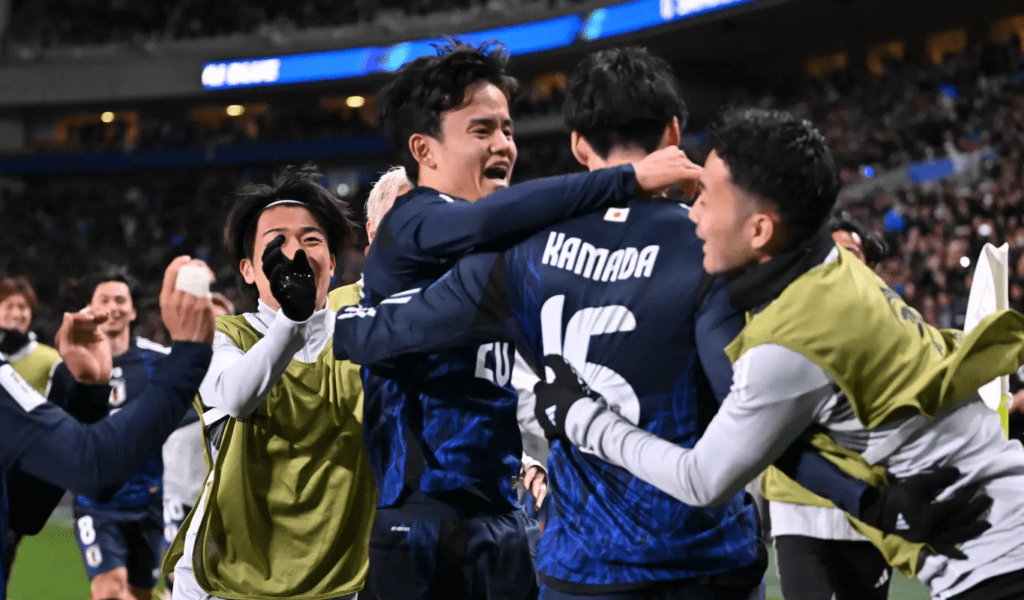Japan’s men’s national soccer team’s progress across its seven previous World Cup appearances mirrors the country’s rise in the global soccer scene. This growth is the result of three decades of professional development and grassroots efforts, producing players ready for European competition.
On Thursday, Japan officially extended its streak of consecutive World Cup qualifications to eight, securing a 2-0 victory over Bahrain. This made Japan the first non-host nation to qualify for the 2026 World Cup, which will take place in the US, Canada, and Mexico.

As the Samurai Blue head to North America next year, some team members will reflect Japan’s broader societal shift toward greater diversity. “Some players may have different roots, but their circumstances differ—whether they were born Japanese or naturalized,” said Japan’s head coach Hajime Moriyasu after the win. “It’s not about who they are, but that they’re all playing for Japan, aiming to be No. 1 in the world.”
Athletes with multicultural backgrounds are increasingly visible in Japanese sports, from mixed-race (haafu) figures like Naomi Osaka and Rui Hachimura to naturalized players who helped Japan’s rugby team reach the 2019 World Cup quarterfinals.
While baseball remains Japan’s most popular team sport, soccer fields across the country are where Japan’s evolving relationship with multiculturalism is most visible. “Baseball requires significant financial investment, making it less accessible to immigrant children,” says Lawrence Yoshitaka Shimoji, a transnational sociology expert. “In contrast, soccer only requires a ball, making it more accessible for haafu and immigrant children in Japan.”
The influence of multiculturalism on Japanese soccer dates back decades. Many early foreign players were from Brazil, where Japan’s largest diaspora originated in the early 20th century. Nelson Yoshimura, a Japanese-Brazilian, joined Japan’s Yanmar Diesel (now Cerezo Osaka) in 1967, earning 46 senior caps after naturalizing in 1970. Other Brazilian players, including those without Japanese heritage, followed, such as Rui Ramos, who helped Japan win the 1992 Asian Cup and nearly led them to their first World Cup in 1993.
Wagner Lopes became Japan’s first naturalized World Cup player at France 1998, and Alessandro Santos represented Japan in the 2002 and 2006 World Cups. In 2010, Marcus Tulio Tanaka, a third-generation Japanese-Brazilian, helped Japan reach the last 16 in South Africa.
Veteran journalist Michael Plastow observes, “Japanese fans supported naturalized players just like Japanese-born players. If anything, there was a sense of gratitude.”
At the same time, Japan’s demographics were shifting. A wave of Brazilian and Peruvian workers in the 1980s and 90s led to increased immigration from Southeast Asia and Africa. Despite a significant drop in the birth rate between 1987 and 2022, the number of births to non-Japanese parents rose from 1.3% to 4.1% during that period.
This change is reflected in the increasing number of haafu players called up to Japan’s national team, with four on the 2024 Olympic squad and at least one on every World Cup roster since 2014. The last two World Cup cycles saw haafu goalkeepers like Daniel Schmidt, Zion Suzuki, and Leo Brian Kokubo representing Japan.
These players have thrived in the physically demanding goalkeeper position, which Japan has traditionally struggled to develop. With players like 6ft 3in Suzuki, 6ft 4in Kokubo, and Taishi Brandon Nozawa, Japan could field its tallest-ever World Cup goalkeeper. Yet, they’ve also faced challenges growing up in a society that hasn’t always accepted them.
A nationwide survey conducted last year by Shimoji and researcher Viveka Ichikawa revealed that nearly all mixed-race respondents had faced microaggressions, with 68% experiencing bullying and racial discrimination. Almost half reported mental health issues, a rate five times the national average.
Musashi Suzuki, a Jamaican-Japanese forward, shared his experience in 2021: “Japanese aren’t used to seeing people who don’t look like them. As Japan becomes more global, I think society is slowly changing.”
Despite these shifts, racial abuse towards haafu players, especially those of Black heritage, has grown on social media. Zion Suzuki, whose father is Ghanaian, publicly urged fans to stop sending discriminatory comments during the 2023 Asian Cup, where Japan was eliminated in the quarterfinals. “I’ve received discriminatory comments since elementary school, but I won’t give in to them,” Suzuki said. “I want to share my story in hopes of helping other athletes and children of diverse backgrounds.”
While soccer’s global nature is often tied to immigration, Japan’s rise of haafu players in the national squad is a story of integration. For mixed-race players raised in Japan, there’s no question of their loyalty. “Once you’re in the national team, you’re the same as everyone else,” said Kein Sato, a Colombian-Japanese attacker. “When you wear the Hi no maru [Japanese flag], you fight like hell for Japan, whether you’re haafu or pure Japanese.”
